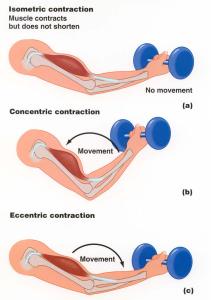Tags
eccentric training, hypertrophy, Isokinetic, Isometric, Isotonic, muscle actions, muscle strength, tendinopathies rehabilitation
Why should you care about the different actions our muscles incorporate while exercising? Because training muscles that integrate these actions improves overall sports performance, helps prevent injuries and contributes to their strength and size.
When muscle are activated they create a tension that make them contract while under force. Contractions allow muscles to shorten, lengthen or stay the same.
The three major muscle actions are: Isometric, Isokinetic and Isotonic (Dynamic).
Isometric
Isometric muscle action involves a contracting of a muscle in a held position, there are no changes in a joint angle. This type of movement is usually performed against a wall, weight machine or another part of the body. Strength gains are usually made at the joint angle closest to where the exercise is performed. Rehabilitation exercises often include Isometric actions. Examples of Isometric exercises include planks, wall squats and pausing at either the concentric or eccentric phase (phases described below).
Isokinetic
Isokinetic muscle actions are performed on special equipment (dynamometer) in which a fixed speed is set and any applied force results in an equal reaction force throughout the range of movement (ROM). Because of the specialized equipment that is needed to perform this muscle action, this type of exercise is typically used in rehabilitation settings.
Isotonic (Dynamic)
Isotonic muscle actions have movement. Muscles are not held.
There are two types of Isotonic muscle actions:
Concentric– also known as positive contraction/training, these are exercises that involve the shortening of a muscle against tension. When performing a bicep curl, the pull upwards is the concentric phase.
Eccentric– also known as negative contraction/training, these are exercises that involve the lengthening of the muscle against tension. When performing a bicep curl, the lowering of the weight is the eccentric phase. Other examples include descending a hill and exercises such as negative sit-ups and the Nordic hamstring.
THE BENEFITS OF ECCENTRIC TRAINING – A GENERAL OVERVIEW
Isometric training (a pause between the eccentric and concentric phase) can also be implemented into one’s training, but for the purpose of this post; the focus is on the eccentric phase.
Most of us concentrate on the part of exercise that incorporates the concentric phase of training and pay little attention to the eccentric phase.
According to the American Council on Exercise (ACE), a normal weight resistance program will have a concentric tempo (lifting speed) of about 1-2 seconds and an eccentric tempo of about 1-2 seconds. The American College Of Sports Medicine (ACSM) recommends 3 seconds for each phase.
Specific eccentric training tempo differs from a typical weight resistance program. Incorporating this training into your routine can lead to greater muscle hypertrophy (growth in muscle fiber size) and strength, reduce muscle strain and aid in the rehabilitation of tendinopathies.
ECCENTRIC TRAINING INCREASES HYPERTROPHY AND STRENGTH
Hypertrophy
Different lifting speeds produce different results. The faster the speed of a muscle contraction the lower the tension on the muscle. A slow speed in the eccentric phase creates a greater tension on the muscles compared to the concentric phase.
The greater the tension on the muscle, the greater the opportunity for hypertrophy.
According to ACE fitness, a typical program that focuses on hypertrophy will have a concentric tempo of about 1-2 seconds and an eccentric tempo of about 2-4 seconds. The National Strength and Conditioning Association (NSCA) recommends an eccentric phase of 3-8 seconds depending on the exercise being performed.
The tempos for both the normal weight resistance program (1-3 seconds), and the hypertrophy training can vary depending on the fitness level of the athlete and the type of exercise being performed.
Strength Gains
Muscles contractions have been shown to generate greater force of approximately 30-60% (NSCA) during the eccentric phase compared to the concentric phase. This allows an athlete the opportunity to incorporate heavier weights into an eccentric training. The heavier the weight (overload training) the greater the opportunity for muscle strength. A spotter is recommended to assist with the concentric part of the lift, while the eccentric phase can be performed alone.
The energy expenditure in the eccentric phase is low compared to the concentric phase. A lower energy expenditure allows for a greater volume of performance without the ensuing extreme fatigue. This is advantageous for both hypertrophy and strength gains.
ECCENTRIC TRAINING HAS BEEN SHOWN TO REDUCE MUSCLE STRAIN AND AIDS IN TENDINOPATHIES REHABILITATION
Muscle strain
Muscle strains are common and occur when muscles are lengthened and loaded during activity beyond their resting length. Medical research has grown over recent years in regard to the role of eccentric training and muscle strain and in particular the part it plays in hamstring injuries and re-injuries. An often cited randomized control study of 943 Danish soccer players found that an experimental group performing the eccentric Nordic hamstring exercise for 10 weeks along with their seasonal training resulted in 15 hamstring injuries throughout the season.The controlled group experienced 52 hamstring injuries. The conclusion of this study found that eccentric hamstring exercise decreased the rate of new and recurrent acute hamstring injuries.
Tendinopathies
Tendon injuries are often the result of overuse syndrome. Research has shown that tendons have a lower capacity for oxygen consumption compared to skeletal muscle. This, in part, contributes to slower tendon healing time. Eccentric training requires less oxygen consumption than concentric training, thus, allowing for a quicker tendon recovery. Other positive changes as a result of this training include changes in tissue structure, reduction of fluid in tendon, reduction in pain and an increase in strength of the impacted area.
Several studies corroborate that eccentric training is an effective treatment for tendinopathies.
Eccentric training should only be performed once a week. Delayed onset muscle soreness (DOMS) is common requiring a longer recovery period.
This post is a general overview regarding important components of eccentric training. If you would like more information, please leave a comment…
REFERENCES
Paul C. LaStayo, PT, PhD1, John M. Woolf, PT, MS, ATC2, Michael D. Lewek, PT3Lynn Snyder-Mackler, PT, ScD4, Trude Reich, BS5, Stan L. Lindstedt, PhD6, Eccentric Muscle Contractions: Their Contribution to Injury, Prevention, Rehabilitation, and Sport, JOSPT, October 2003, Web 7, June 2017
Daniel Lorenz, DPT, PT, ATC/L, CSCS,Use of eccentric exercise for prevention and rehab, 2012, Februaury, Web 7 June 2107.
Daniel Lorenz, DPT, PT, ATC/L, CSCS, USAW1 and Michael Reiman, PT, DPT, OCS, SCS, ATC, AAOMPT, CSCS2, The Role And Implementation of eccentric training in Athletic Rehabilitation:Tendinopathy, Hamstring Strains, and ACL Reconstruction, NCBI, 2011 March, Web 7 June,2017.
Pete McCall, MS, CSCS, How to Select the Right Sets and Tempo for Your Clients, ACE, 3 July 2014, Web 7 June 2017.
Jonathan Mike, PhD, CSCS*D, NSCA-CPT*D, USAW, 1 Chad M. Kerksick, PhD, ATC, CSCS*D, NSCA-CPT*D,2 and Len Kravitz, PhD, How to Incorporate Eccentric Training Into a Resistance Program, NSCA, 2015 February, Web 7 June, 2017.
Brett L Woodley, Richard J Newsham‐West, and G David Baxter, Chronic tendinopathy: effectiveness of eccentric exercise, NCBI, 4 APRIL, 2007, Web 7 June 2017.
Eccentric Resistance Exercise for Health and Fitness, ACSM, Web 7 June 2017.
Personal Fitness Training Theory & Practice, Aerobics and Fitness Association of America, 2015.



Pingback: Do You Know Your Stuff? Take This Exercise and Nutrition Quiz |